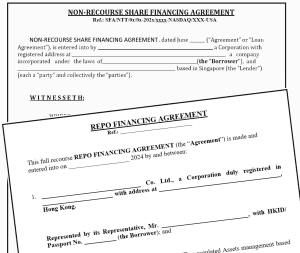Non-Recourse Stock Loans
Non-Recourse Stock Loans Leverage Stock Portfolios to Raise Capital
 Non-recourse stock loans are not a new concept in the global marketplace. For a number of years, stock loans and equity loans were only available to high net worth clients with accounts at large international institutions.
Non-recourse stock loans are not a new concept in the global marketplace. For a number of years, stock loans and equity loans were only available to high net worth clients with accounts at large international institutions.
These loans provide borrowers with access to funds secured by their stock portfolios without requiring personal guarantees or recourse to other assets.
Oceanview Consultant Partners is one of few alternative legitimate sources to introduce this stock loan product to a wider range of customers in an effort to democratize alternative financial solutions.
Introduction
In the world of finance, non-recourse stock loans have gained traction as a viable option for investors seeking liquidity without relinquishing their stock ownership. This financial instrument offers a unique opportunity for investors to leverage their stock portfolios as collateral without bearing personal liability beyond the pledged assets. This article delves into the intricacies of this securities based lending program.
Understanding Non-Recourse Stock Loans
Using shares as collateral for loans are financial arrangements where borrowers pledge their stock holdings as collateral to secure a loan from a lender. Unlike traditional loans, where personal assets and creditworthiness often serve as collateral, non-recourse loans rely solely on the value of the pledged stocks. In the event of default, the lender’s recourse is limited to the liquidation of the pledged collateral and the borrower is not personally liable for any shortfall.
Mechanics of Non-Recourse Stock Loans
The process of obtaining a non-recourse stock loan typically involves several key steps:
Evaluation of Collateral: Lenders assess the value and liquidity (trading volume) of the borrower’s stock portfolio to determine the loan-to-value (LTV) ratio. For example if your stock is valued at USD 5.00 and the LTV is 50% the lender would potentially loan USD 2.50 per share.
Higher-quality stocks for example securities with exceptional earnings per share, solid business models, dividends paid to shareholders and stable trading volume (more liquidity) command higher LTV ratios. This evaluation provides borrowers with greater borrowing power.
Loan Terms and Conditions: Once the collateral valuation is complete, lenders offer loan terms, including amount of funding and scheduled tranches, interest rates, loan duration, and LTV ratio by issuing a Term Sheet. Borrowers have the opportunity negotiate these terms with the lender based on their financial needs and risk tolerance.
Stock Pledge and Disbursement: Upon agreement of terms by both parties the lender will issue a stock loan agreement to the borrower defining terms and conditions of the loan. Borrower is required to open an account in their name at lenders custodial brokerage and pledge their stock holdings as collateral. The lender then disburses the loan proceeds within 48 hours via an internal DVP (Delivery Versus Payment). The pledged stocks remain under the borrower’s ownership, but gives the lender full power and control over the custodian account and the collateral during the loan term.
Repayment and Redemption: Borrowers typicality make quarterly or semi-annual simple interest payments according to the loan agreement. At the loan’s maturity or upon repayment, borrowers redeem the collateral by repaying the principal amount, plus accrued interest. Alternatively, by mutual agreement borrowers may choose to extend the loan term or surrender the collateral to settle the debt.
Typical Terms of a Non-Recourse Securities Loan
- Funding Schedule: Amounts in tranches (funds released against collateral)
- Number of Shares to Pledge
- Interest Rate: 5% – 6.5% simple per annum
- Term: 12 – 36 months (can be longer depending on collateral)
- Lock up Period: Usually no prepayment for 12 months
- Currency: Funds to be disbursed in USD, South Korean Won, Singapore Dollar, Hong Kong Dollar etc.
- Administration Fee: .05%-1% one time payment
- Origination Fees: 4%-5%
Benefits of Non-Recourse Stock Loans
Securities based lending offer several advantages for both borrowers and lenders:
 Liquidity without Selling: Investors can unlock the value of their stock holdings without selling their shares, allowing them to maintain exposure to potential price appreciation and dividends.
Liquidity without Selling: Investors can unlock the value of their stock holdings without selling their shares, allowing them to maintain exposure to potential price appreciation and dividends.
Flexible Use of Funds: Borrowers can use the loan proceeds for various purposes, including investment opportunities, personal expenses, debt consolidation, or business expansion, without restrictions imposed by traditional lenders.
No Personal Liability: Since the loan is secured by the pledged stocks, borrowers are shielded from personal liability in the event of default. Lenders’ recourse is limited to the pledged assets, preserving borrowers’ other assets and creditworthiness.
Potential Tax Benefits: Interest payments on non-recourse stock loans may be tax-deductible, providing potential tax advantages for borrowers, subject to individual tax circumstances and regulations.
Efficient Capital Deployment: Non-recourse stock loans enable investors to leverage their existing assets efficiently, potentially enhancing returns on investment by accessing additional capital at competitive interest rates.
Risks and Considerations
While non-recourse stock loans offer compelling benefits, they also entail certain risks and considerations:
 Market Volatility: Fluctuations in stock prices can affect the loan-to-value ratio, potentially triggering margin calls or requiring additional collateral to maintain the loan’s security.
Market Volatility: Fluctuations in stock prices can affect the loan-to-value ratio, potentially triggering margin calls or requiring additional collateral to maintain the loan’s security.
Interest Rate Risk: Changes in interest rates can impact the cost of borrowing, potentially increasing the burden of interest payments for borrowers over the loan term.
Collateral Risk: If the value of the pledged stocks declines significantly, borrowers may face the risk of collateral shortfall, requiring additional assets or repayment to satisfy the loan obligations.
Counterparty Risk: The reputation and financial stability of the lender are crucial factors to consider, as borrowers rely on the lender’s ability to fulfill its obligations under the loan agreement.
Regulatory Considerations: Stock loans with no-recourse for the loan but the underlying securities pledged may be subject to regulatory scrutiny, particularly regarding disclosure obligations.
Practical Applications
Non-recourse stock loans are utilized by a diverse range of investors and entities for various purposes:
High-net-worth individuals may use non-recourse stock loans to finance luxury purchases, real estate investments, or estate planning strategies without liquidating their stock portfolios.
Entrepreneurs and business owners may leverage non-recourse stock loans to raise capital for business ventures, acquisitions, or expansion initiatives, leveraging their personal stock holdings as collateral.
Institutional investors and hedge funds may utilize non-recourse stock loans for short-term liquidity needs, portfolio hedging strategies, or arbitrage opportunities, optimizing capital efficiency and risk management.
Conclusion
Non-recourse stock loans represent a flexible and efficient financing solution for investors seeking liquidity while retaining ownership of their stock portfolios. By leveraging their assets as collateral, borrowers can access capital for various purposes without incurring personal liability beyond the pledged stocks.
However, careful consideration of the risks, terms, and regulatory implications is essential to make informed decisions regarding non-recourse stock loans. With proper diligence and understanding, investors can effectively utilize this financial instrument to achieve their financial objectives while managing risk effectively in dynamic market environments.



